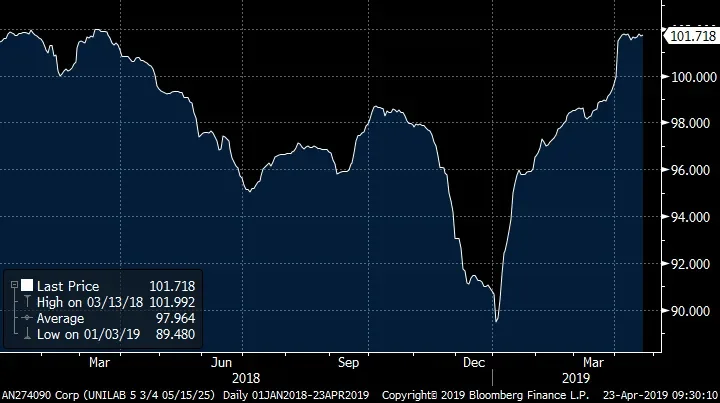‘Building Par’ for CLO Bondholders
In a recent blog we analysed the behaviour of some CLO managers during their investment into the olive oil producer Deoleo, which has experienced a fairly steady decline over the last four years. However, CLO managers are meant to earn their fees by creating value for their deal and its investors, so today we are going to take a look at an example of this.
The end of 2018 and beginning of this year has been a tough time for credit, but it has also created an opportunity for CLO managers to invest in good companies at cheaper prices. One name they may have been looking at is Unilabs, a Swiss company with operations all over Europe focusing on providing medical imaging and laboratories services. The company is rated B2 and its senior unsecured bonds are rated Caa1 (both by Moody’s). Leverage is high – around 7x – as the company is pursuing a strategy of consolidation with smaller players in the market, completing 17 acquisitions in 2018 alone. However, it has also had some success in implementing cost synergies, reporting over 3% EBITDA growth in the latest financial year.
Given the firm’s high leverage and low rating, it is easy to imagine how its debt performed in the final quarter of 2018 and the first few weeks of 2019, but it has since recovered on the back of Unilabs securing extensions on most of its client contracts and performing in line with expectations.

This has been an opportunity for CLO managers to “build par”, which essentially means increasing the value of the pool collateralising the CLO. The par build is important as it enhances the structural protection that CLO bondholders benefit from by increasing over-collateralisation. According to data from Reuters LPC, no CLO managed to pick up the bond at its lowest price of around 89.5, but a number of them did take the opportunity to invest once it had recovered to the mid-90s, building around five points of par with the trade. As an example, a €4m investment at that level for a typical CLO would have increased the credit enhancement on the deal’s BBB rated tranche of bonds by 5bp.
As fixed income investors our number one priority is capital preservation, so it is important for us that CLO managers identify weaker credits and know to exit early to limit the downside. Nevertheless, when investing in a managed pool of loans, it is good to see managers taking on small amounts of risk in names they believe in in order to add value for bondholders.
The next stage of our analysis will now be ensuring this extra value will not benefit only the equity investors of the deal; some CLOs allow, within their documentation, the distribution of cash to equity holders equal to the par built. This is one of the reasons why we consider analysing the documentation so important in the primary market, as it allows investors like us to demand such features are completely removed or tightly limited if we are to participate.
Our second line of defence from these features is investing in conservative managers, as they have the ultimate discretion on whether to make such distribution to the equity holders. While some managers will aggressively use this discretion to enhance short term equity returns, the majority recognise the long term value of having a higher level of over-collateralisation in a deal. It gives them the ability to navigate periods of market stress without worrying about breaching performance triggers, meaning they can focus on investing in sound, cheap companies once again to generate value.
As CLO bondholders we constantly monitor levels of par build, as well as managers’ behaviour when it comes to distributing trading profits, as one of the key variables in determining relative value when taking investment decisions.
